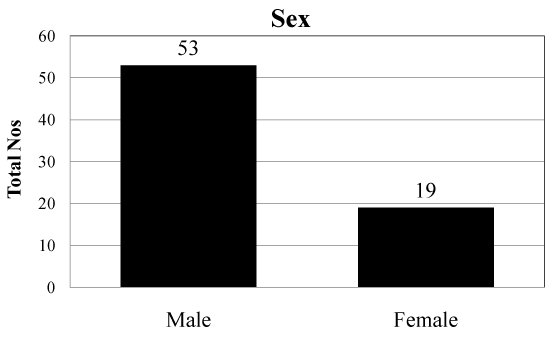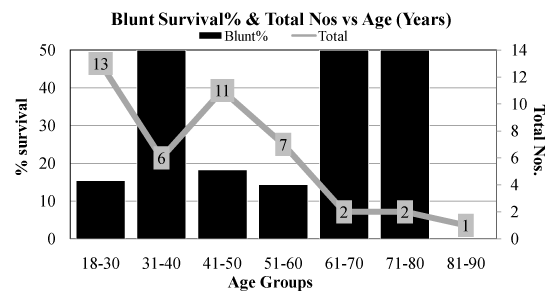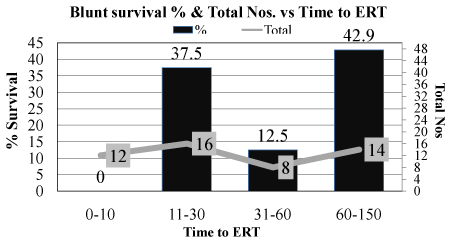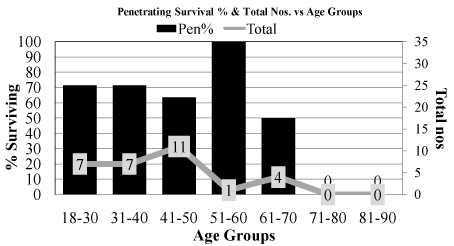Introduction: Emergency room thoracotomies (ERT) are a last ditch effort in salvaging dying trauma patients. The Royal Adelaide Hospital (RAH) has a protocol for the use of ERT with thoracotomy being initiated when the systolic BP remains <60mmHg despite maximal resuscitation. ERT is in the form of clam-shell thoracotomy as it yields excellent exposure. This study analyses the outcome of these patients in our institution.
Methods: Patients who underwent ERT were identified from the RAH trauma database and reviewed. Patients were divided into penetrating or blunt trauma and overall mortality and major morbidity were considered as primary study endpoints.
Results: From 2005 to January 2014, 72 patients underwent ERT. 42 were for blunt and 30 were for penetrating trauma. Overall survival was 66.67% and 23.8% for penetrating and blunt trauma patients respectively. 83.3% of emergency room thoracotomies successfully restored spontaneous circulations and these patients were transferred from the emergency department (ED) to the operating theatre for further treatment. Blunt ERT performed within 10 minutes of arrival had 0% survival while penetrating ERT within first 10 minutes had a 33.33% survival. If the first 10 minutes of blunt ERT’s were excluded, blunt ERT survival was 33.3%. One patient developed a CVA. Blunt cardiac ruptures had 88.9% mortality, whilst penetrating cardiac injuries had a 69% survival.
Conclusion: This study has shown that ERT in penetrating and blunt trauma patients who are in extremis can achieve a survival rate of 66.7% and 23.8% respectively.
emergency resuscitative thoracotomy, thoracotomy, severe trauma, blunt trauma, penetrating trauma
The use of emergency room thoracotomy (ERT) in trauma is a last ditch attempt to resuscitate a dying patient where other techniques have failed. Patients who undergo this procedure are deemed too unstable to be able to be safely transferred to an operating theatre or who have gone into fulminant cardiac arrest. The procedure is generally in the form of an anterolateral thoracotomy and this may be extended across the midline in the form of a clamshell incision [1]. The pericardium is opened to relieve any tamponade, any obvious sources of haemorrhage are controlled, internal cardiac massage can be instituted and the aorta can be cross-clamped [1]. Following these maneuvers, the patient will then be transferred to an operating theatre for further definitive surgical intervention.
It has a well-accepted role in the management of dying patients with penetrating thoracic trauma [2-6]. Survival rates are variable depending on the institution with rates of 8-12% being commonly cited [3-5,7]. Some centres have shown better results up to 40% and above survival [8,9]. It is thought that without the thoracotomy being performed, the patient would succumb to their injuries.
Its role in the management of dying blunt trauma patients is more controversial however. The rates of survival described are almost universally poor and are usually in the order of 0-2% [10-12]. In those that do survive, the rates of catastrophic, hypoxic brain injury are in the order of 15% [11]. As a result, some centres describe it as being a futile procedure and that it has no role in the management of blunt trauma [11].
The results of ERT appear to be best when patients have shown signs of life within the emergency department or just prior to arrival [12,13]. Once patients have gone into fulminant cardiac arrest, the mortality rates are exceedingly high [12]. Therefore, it is thought that if patients are rapidly deteriorating despite maximal resuscitation efforts, ERT would be more effective in the resuscitation of the patient and this would be reflected in a higher rate of survival, regardless of the mechanism.
The Royal Adelaide Hospital trauma unit has developed a protocol on the use of ERT in the trauma patients who are rapidly dying but are pre-arrest. This study aims to review our experience and survival with this technique.
Protocol
The Royal Adelaide Hospital has trauma surgeons who are included in the trauma resuscitation team and are present when the patient arrives in the resuscitation room. Any patient whose blood pressure deteriorated to and remained below 60 mmHg despite maximal resuscitation efforts will undergo a protocol driven ERT. For the first 4 years, this was in the form of an anterolateral thoracotomy but since 2009, clamshell thoracotomies have been exclusively performed as it provides better exposure. This protocol has been approved by the institutional review board and is subjected to regular auditing and reviews.
The protocol is applied equally to blunt and penetrating trauma. A summary of the protocol is as follows: Where an arterial line is not available, the RAH ERT protocol assumes a systolic pressure of 80mmHg if there is a palpable radial pulse, a pressure of 70mmHg in the presence of a femoral (and carotid) pulse, and a pressure of 60mmHg with only a carotid pulse. These figures are generally similar to arterial line pressures where available. When the systolic pressure falls below 70 mmHg with disappearance of the femoral pulses, the thoracotomy set is made available in the resuscitation room. If further deterioration occurs despite maximal resuscitation and the carotid pulses disappear (i.e. pulseless), indicating a BP below 60 mmHg, a clamshell thoracotomy is initiated. We try to perform ERT before cardiac arrest occurs, although this is not always possible.
Thoracotomy technique
All patients require a general anaesthetic with rapid sequence induction. Rapid skin preparation is affected with povidone-iodine. It must of course be remembered that this is not an elective procedure and sterility is not up to theatre standards. A clamshell thoracotomy is performed, the incision 1 cm below the nipples from mid axillary line to mid axillary line. An appropriate intercostal space is identified, opened 2 to 3 cm and then extended carefully to avoid lung injury. A Lebschke knife is used to divide the sternum.
Once the chest is opened, the pericardium is always opened in a cranial-caudal direction as a haemopericardium is not always evident macroscopically. Bimanual internal cardiac massage is then started if so required. All patients will have initial digital aortic compression above the diaphragm in order to help raise the blood pressure to maintain and increase cardiac and cerebral perfusion. As one person cannot safely perform internal cardiac massage and digital aortic compression simultaneously, a second person is required. Cardiac massage using one hand only is potentially unsafe and may cause cardiac injuries via the thumb so a two-handed technique is used. Using a vascular clamp for aortic occlusion can be difficult and in the majority of our patients we exclusively use digital aortic occlusion. In addition in 50% of patients there are adhesions in the chest and the lungs often are massively inflated. These interfere with aortic exposure, and represents wasted time when digital aortic occlusion can be performed quickly and safely.
If required, haemorrhage control is obtained in the chest. This of course is not required in many patients as the thoracotomy has been performed for circulation restoration primarily with bleeding control as required. Abdominal haemorrhage is of course controlled by the aortic occlusion. Once circulation has been restored to a safe level, the patient is transferred to theatre for further operative intervention.
All patients who underwent ERT from 2005 to January 2014 were identified from the Royal Adelaide Hospital Trauma Database and reviewed. Data collected included age, sex, time of arrival, mechanism of injury, Injury Severity Score, presence of organ injury, timing of thoracotomy, presence and timing of cardio-respiratory arrest prior to thoracotomy. Any major neurological, infective or other major morbidity following thoracotomy was noted. Resuscitative thoracotomy was considered to be successful when the patient was able to be transferred to the operating theatre and this was recorded. Overall survival was the primary endpoint and this was recorded. Written approval was obtained from the Royal Adelaide Hospital Research Ethics Committee for this study.
72 patients underwent ERT from 2005 to beginning of 2014; this works out to 1 thoracotomy every six weeks. There were 53 male and 19 female patients (Figure 1). The ages ranged from 18 to 82 years, with a mean 41.88 and a median of 42 years. 42 ERTs were for blunt trauma and 30 were for penetrating trauma.

Figure 1. Gender distribution.
The overall Injury Severity Score (ISS) ranged from 10-75, with an average of 37.19. Blunt ERT ISS ranged from 10-75, with an average of 37.19. Penetrating ERT ISS ranged from 9-75, averaging 36.13. 45.1% of patient was admitted during working hours and 54.9% afterhours.
Successful emergency room thoracotomy was determined by successful ED circulation restoration and transferred to theatre. 83.33% of patients (60 out of 72 patients) had successful ERT’s. Of those, a further 18 patients died in theatre and a 12 died in ICU.
Overall, 41.7% of patients (30 out of 72 patients) survived. Overall survival was 66.67% (20 out of 30 patients) of ERT’s for penetrating trauma and 23.8% (10 out of 42 patients) for blunt trauma.
ERT for blunt trauma
Figure 2 shows the age group relationship to survival. The 18 to 30 age group had a 15.4% survival, the 31 to 40 group showed a 50% survival, the 41 to 50 group 18.2% survival, the 51 to 60 group a 14.3% survival, and the 61 to 70 and 71 to 80 groups had 50% survival each. There was only one patient in the 81 to 90 age group and that patient did not survive.

Figure 2. Effect of age on survival after ERT in blunt trauma.
Figure 3 shows the blunt ERT survival compared to time of thoracotomy after arrival. All ERT’s performed within the first 10 minutes of arrival did not survive. ERT’s performed on patients who had one or more pre-arrival cardiac arrests with CPR in progress on arrival did not survive the ED thoracotomy. The 11 to 30 minutes group had a 37.5% survival, the 31 to 60 minutes group had 12.5% survival, and the 60 to 150 minute group showed a 42.9% survival.

Figure 3. Effect of timing of ERT on survival in blunt trauma.
The overall survival for blunt ERT is 23.8%, however if the ERT’s performed within the first 10 minutes are excluded, the thoracotomy survival is 33.3%.
ERT for penetrating trauma
The overall survival was 66.7% for ERT’s performed for penetrating trauma. Not every penetration was to the chest and as mentioned above, the ERT was performed for circulation restoration and not necessarily for chest bleeding.
Figure 4 shows the relationship between similar age groups to blunt ERT and survival. The 18 to 30 age group and the 31 to 40 age group each had a 71.4% survival. The 41 to 50 age group showed a 63.6% survival. The 51 to 60 age group had 100% survival and the 61 to 70 age group had a 50% survival. There were no patients in the over 70 age groups.

Figure 4. Effect of age on survival after ERT in penetrating trauma.
As opposed to no survivors from ERT for blunt thoracotomy within the first 10 minutes of arrival, penetrating ERT’s showed a 33.3% survival during this time frame. The 11 to 30 minutes group showed a 72.7% survival and the 31 to 60 and 60 to 150 minutes groups showed 100% survival.
Cardiac injuries
There were 22 cardiac injuries comprising 30.9% of all ERT done for trauma. There were 13 penetrating cardiac injuries of which 9 survived representing a 69.2% survival. There were nine blunt cardiac injuries, of which one survived representing and 88.9% mortality. The mortalities in the blunt cardiac injuries were both from the cardiac injuries and from multiple other blunt injuries.
Complications
There were three cardiac ruptures, 2 in the blunt trauma group. Progressive anterior cardiac wall rupture occurred during internal cardiac massage. This probably represented anterior cardiac wall softening from the blunt cardiac injury. One cardiac rupture occurred in the penetrating group. This patient was successfully resuscitated in the emergency Department, and had the cardiac stab wound repaired in the ED. On the way to theatre, an adrenaline bolus was administered with the arterial line recording a systolic of 300 mmHg. The cardiac repair was disrupted as a result.
One patient developed a brain infarct post operatively. This was the patient with a cardiac stab wound that was initially managed with a Foley catheter with the balloon inflated. It is thought that the patient developed an air embolus that travelled to the brain from the on attempted cardiac repair as the balloon was popped.
There were no instances of empyema. There were no significant wound infections. This is surprising in view of the sub optimal aseptic conditions associated with resuscitative thoracotomies. All patients received intravenous antibiotics peri-operatively. There were five patients who developed chronic pain related to the thoracotomy scar. One patient developed sternal misalignment several weeks after discharge.
The Royal Adelaide Hospital is a Level 1 Trauma Centre in Adelaide, South Australia, and receives approximately 75% of all trauma patients in South Australia. The RAH has a surgical trauma unit with trauma surgeons, assisted when required by general surgeons, and other sub specialties. The South Africa Cape Town ERT protocol was used as a guideline to the development of the Royal Adelaide Hospital ERT protocol. This protocol covers both blunt and penetrating trauma.
At the RAH clamshell thoracotomy is the preferred incision as it provides excellent exposure to most major thoracic structures, particularly for the inexperienced but even for the experienced surgeon. Our experience favouring clamshell thoracotomy is in keeping with the evidence in the literature [1,14]. Clamshell thoracotomy was found to be superior to other thoracotomy incisions as it provides rapid and definitive access to most thoracic structures for assessment and control [14]. It must be remembered that a clamshell thoracotomy divides both internal mammary arteries and these must be controlled. The majority of patients who required ERT had no or ineffective cardiac activity, therefore requiring bimanual cardiac massage. In Australia it is likely that most ERT will be performed by non-cardiothoracic surgeons. Therefore better exposure through clamshell thoracotomy and digital aortic occlusion avoids iatrogenic injuries and time wastage in aortic exposure for cross-clamping.
Emergency room thoracotomies are not required in the hypotensive but stable patient, nor in the conscious patient as this indicates adequate cerebral perfusion. There are numerous associated risks to staff associated with resuscitative thoracotomies namely iatrogenic injuries from broken ribs, needle-stick injuries and other exposures [15,16]. Communicable diseases are a real danger in this situation [15,16].
The results reported i2021 Copyright OAT. All rights reservthan those described elsewhere. It is thought there are several reasons for this. Firstly, where possible, senior surgical staff will be present upon arrival of the dying patient in the resuscitation room and all ERTs were performed by surgeons. This has been shown elsewhere to be advantageous [10].
Secondly, performing ERT whilst the patient still has a recordable (but low) blood pressure and signs of life. This has been shown to be associated with greater rates of survival [13,17]. Thirdly, instituting a damage control approach with packing with plan for second definitive operation once the patient has been stabilised. Furthermore, our indication for thoracotomy is wider than most where we use it to ensure brain and cardiac perfusion, often at the expense of organs below the diaphragm. It is known that aortic clamping is associated with considerable morbidity to intra-abdominal organs and can lead to liver and renal dysfunction [18,19]. This cohort of patients tends to be young and fit and can generally tolerate and recover from these injuries.
It should be noted there were no survivors in patients that that underwent ERT for blunt trauma within the first 10 minutes of arrival. This corroborates with results from other centres so there does appear to be a degree of futility of the use of thoracotomy in these patients. However, after 10 minutes, the rates of survival rise to 33%. This is likely related to patients actually showing signs of life upon arrival. It also demonstrates that in well-selected patients, ERT can have a profound impact upon survival, even in blunt trauma. It is expected that these patients would have succumbed to their injuries without the use of resuscitative thoracotomy.
In conclusion this study has shown that ERT can achieve a survival rate of 66.7% and 23.8% in penetrating and blunt trauma patients respectively.
Study design: PCB
Data collection: CC and WG
Data analysis: PCB and CD
Manuscript preparation and critical review: PCB, CD and LT
None
No funding has been received for the preparation of this manuscript. This manuscript has been presented at the 2014 ANZAST meeting in Singapore.
- Wise D, Davies G, Coats T, Lockey D, Hyde J, et al. (2005) Emergency thoracotomy: "how to do it". Emerg Med J 22: 22-24. [Crossref]
- Sersar SI, Alanwar MA (2013) Emergency thoracotomies: Two center study. J Emerg Trauma Shock 6: 11-15. [Crossref]
- Seamon MJ, Fisher CA, Gaughan JP, Kulp H, Dempsey DT, et al. (2008) Emergency department thoracotomy: survival of the least expected. World J Surg 32: 604-612. [Crossref]
- Mollberg NM, Glenn C, John J, Wise SR, Sullivan R, et al. (2011) Appropriate use of emergency department thoracotomy: implications for the thoracic surgeon. Ann Thorac Surg 92: 455-461. [Crossref]
- Molina EJ, Gaughan JP, Kulp H, McClurken JB, Goldberg AJ, et al. (2008) Outcomes after emergency department thoracotomy for penetrating cardiac injuries: a new perspective. Interact Cardiovasc Thorac Surg 7: 845-848.
- Johannesdottir BK, Mogensen B, Gudbjartsson T (2013) Emergency thoracotomy as a rescue treatment for trauma patients in Iceland. Injury 44: 1186-1190. [Crossref]
- Rhee PM, Acosta J, Bridgeman A, Wang D, Jordan M, et al. (2000) Survival after emergency department thoracotomy: review of published data from the past 25 years. J Am Coll Surg 190: 288-298. [Crossref]
- Van Waes OJ, Van Riet PA, Van Lieshout EM, Hartog DD (2012) Immediate thoracotomy for penetrating injuries: ten years' experience at a Dutch level I trauma center. Eur J Trauma Emerg Surg 38: 543-551. [Crossref]
- Pahle AS, Pedersen BL, Skaga NO, Pillgram-Larsen J (2010) Emergency thoracotomy saves lives in a Scandinavian hospital setting. J Trauma 68: 599-603.
- Capote A, Michael A, Almodovar J, Chan P, Skinner R, et al. (2013) Emergency department thoracotomy: too little, too much, or too late. Am Surg 79: 982-986. [Crossref]
- Khorsandi M, Skouras C, Shah R (2013) Is there any role for resuscitative emergency department thoracotomy in blunt trauma? Interact Cardiovasc Thorac Surg 16: 509-516. [Crossref]
- Lustenberger T, Labler L, Stover JF, Keel MJ (2012) Resuscitative emergency thoracotomy in a Swiss trauma centre. Br J Surg 99: 541-548. [Crossref]
- Gomez G, Fecher A, Joy T, Pardo I, Jacobson L, et al. (2010) Optimizing outcomes in emergency room thoracotomy: a 20-year experience in an urban Level I trauma center. Am Surg 76: 406-410. [Crossref]
- Simms ER, Flaris AN, Franchino X, Thomas MS, Caillot JL, et al. (2013) Bilateral anterior thoracotomy (clamshell incision) is the ideal emergency thoracotomy incision: an anatomic study. World J Surg 37: 1277-1285. [Crossref]
- Sikka R, Millham FH, Feldman JA (2004) Analysis of occupational exposures associated with emergency department thoracotomy. J Trauma 56: 867-872. [Crossref]
- Feldman JA (2001) Provider risk during medically futile emergency department thoracotomy. Ann Emerg Med 38: 349. [Crossref]
- Edens JW, Beekley AC, Chung KK, Cox ED, Eastridge BJ, et al. (2009) Longterm outcomes after combat casualty emergency department thoracotomy. J Am Coll Surg 209: 188-197. [Crossref]
- Eagleton MJ, Greenberg RK (2010) Spinal and visceral ischemia after endovascular aortic repair. J Cardiovasc Surg (Torino) 51: 71-83. [Crossref]
- Piazza M, Ricotta JJ 2nd (2012) Open surgical repair of thoracoabdominal aortic aneurysms. Ann Vasc Surg 26: 600-605. [Crossref]




